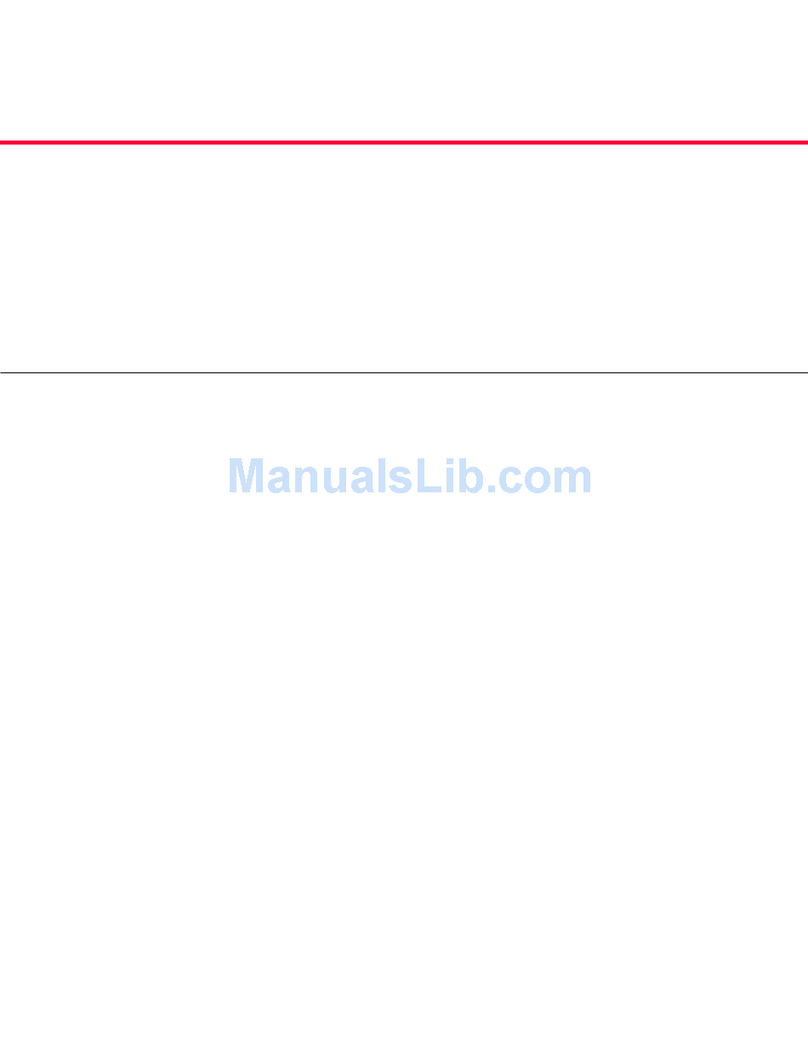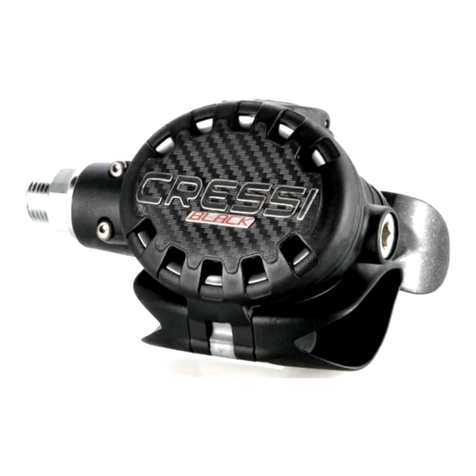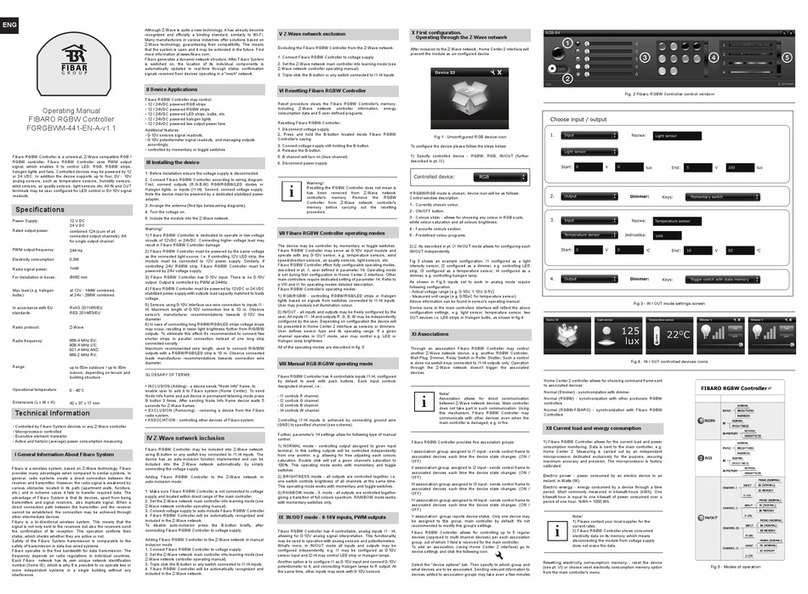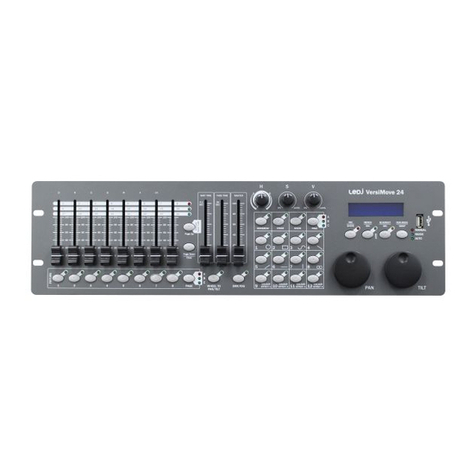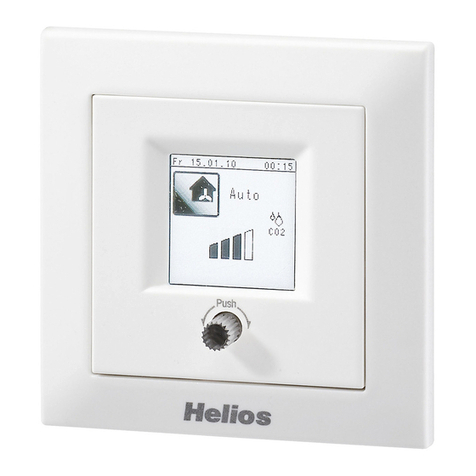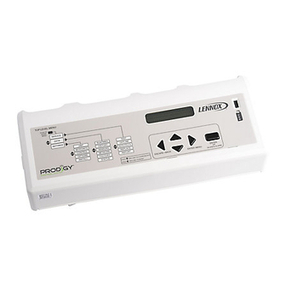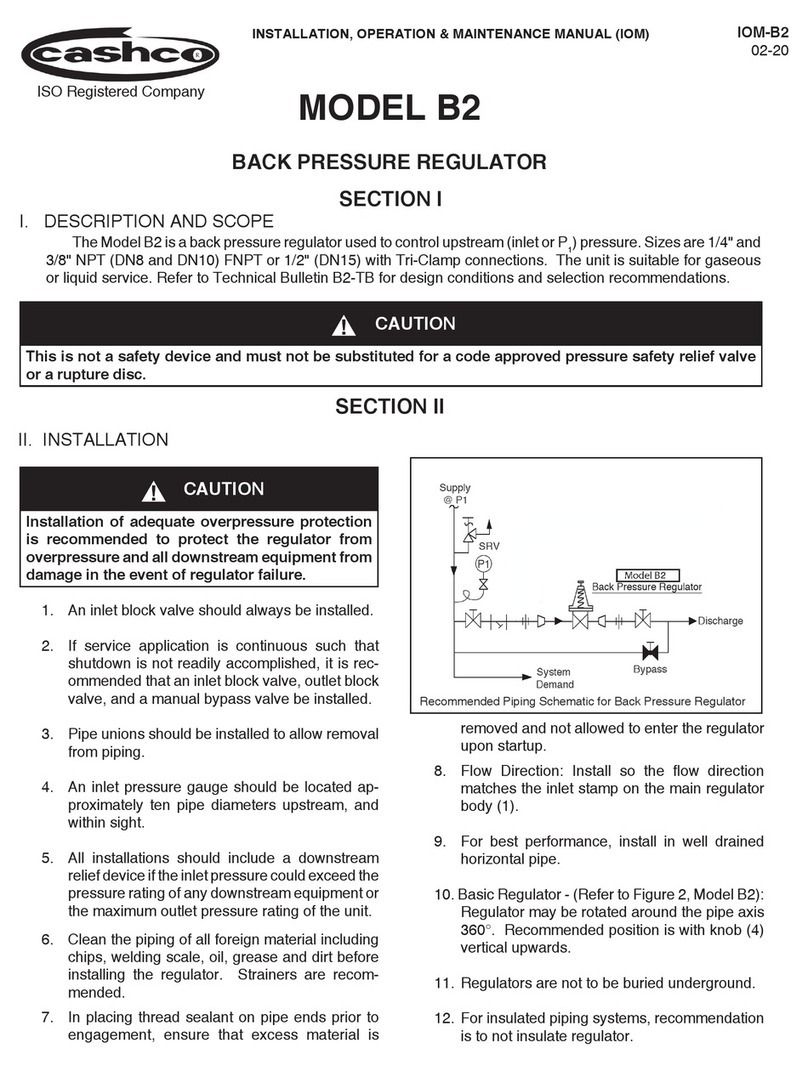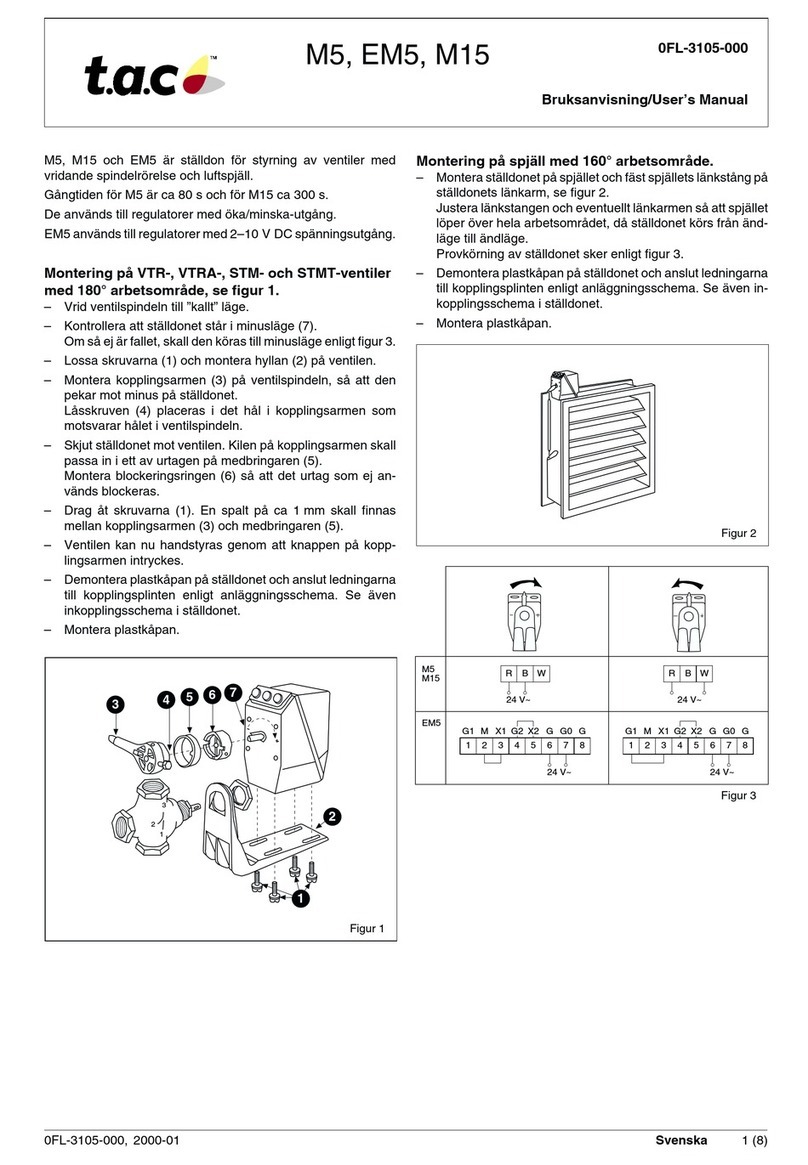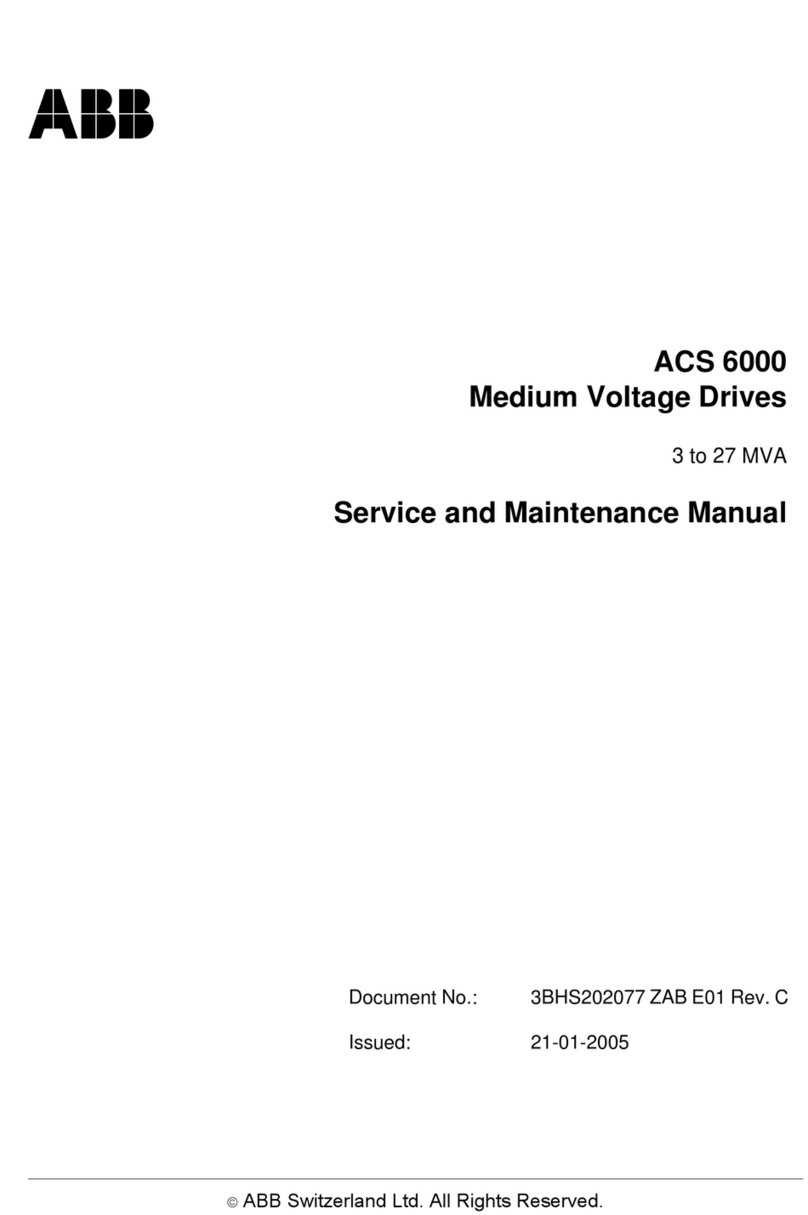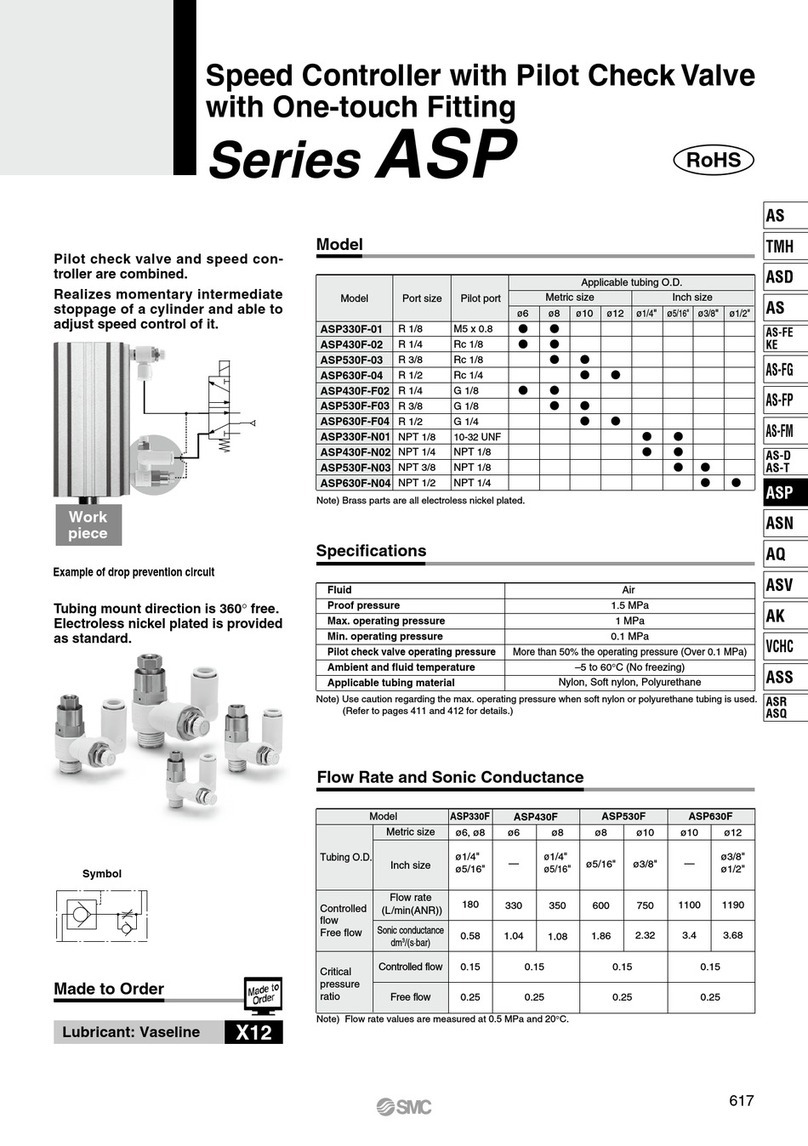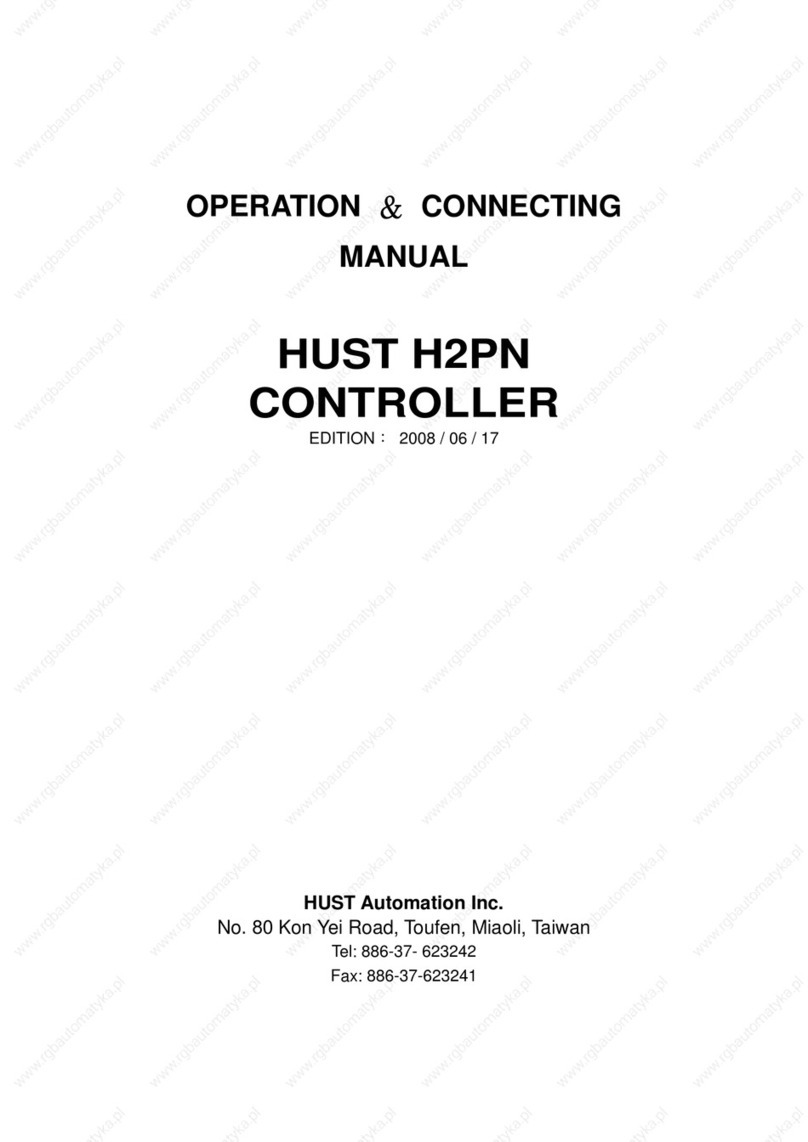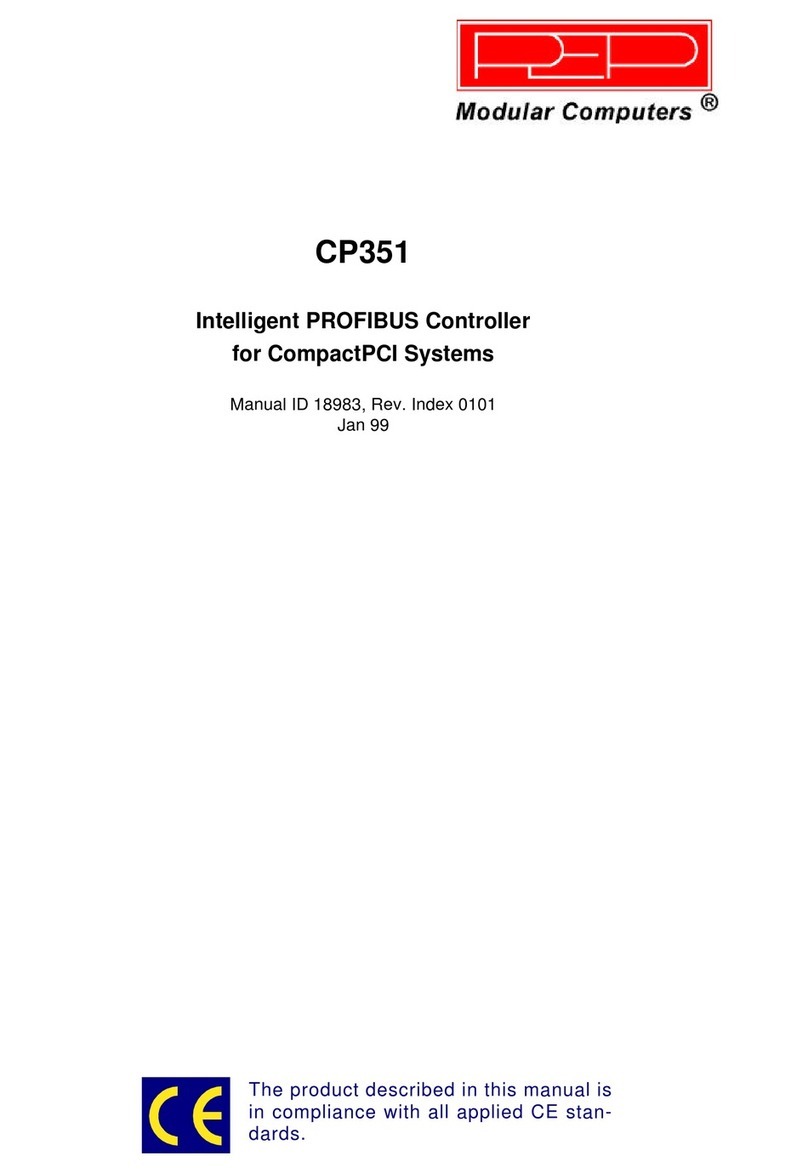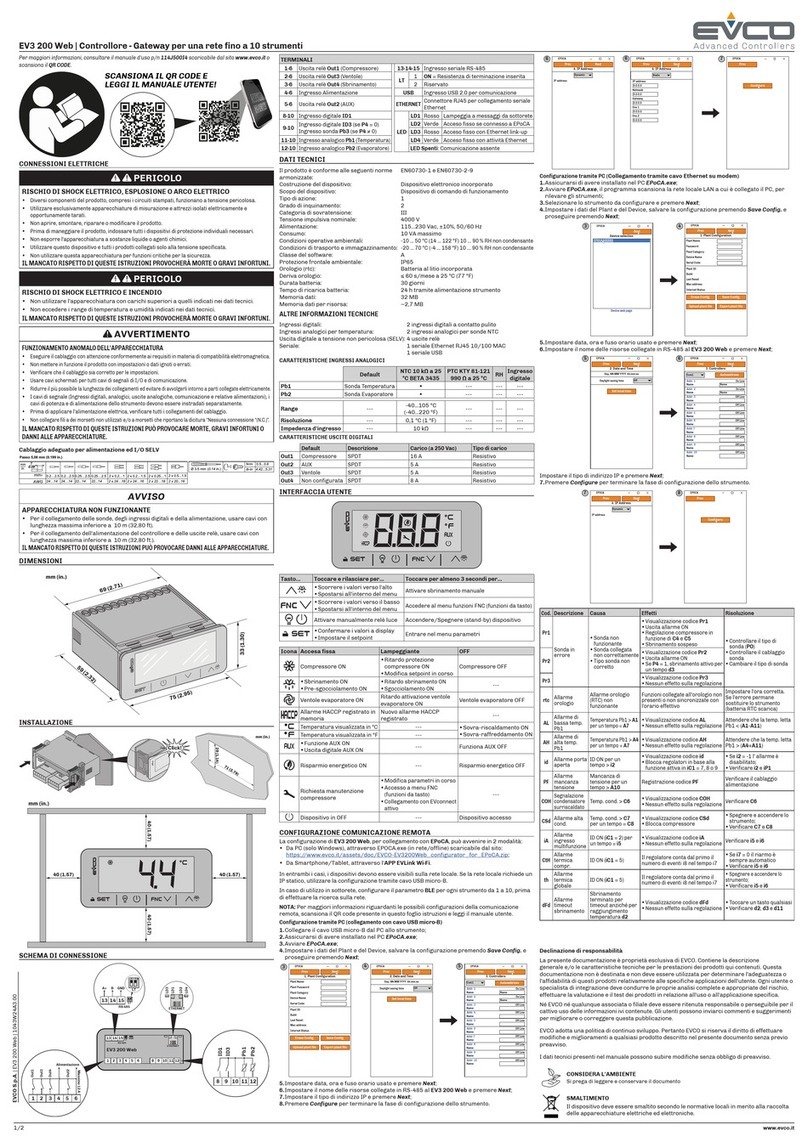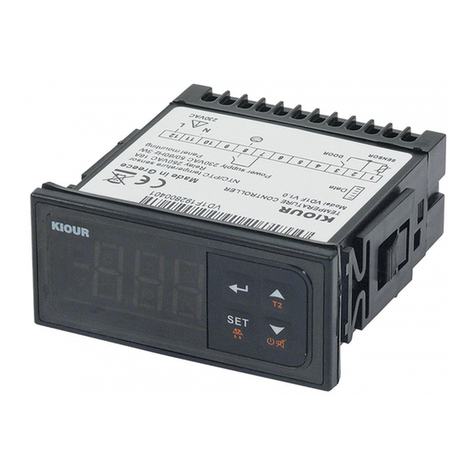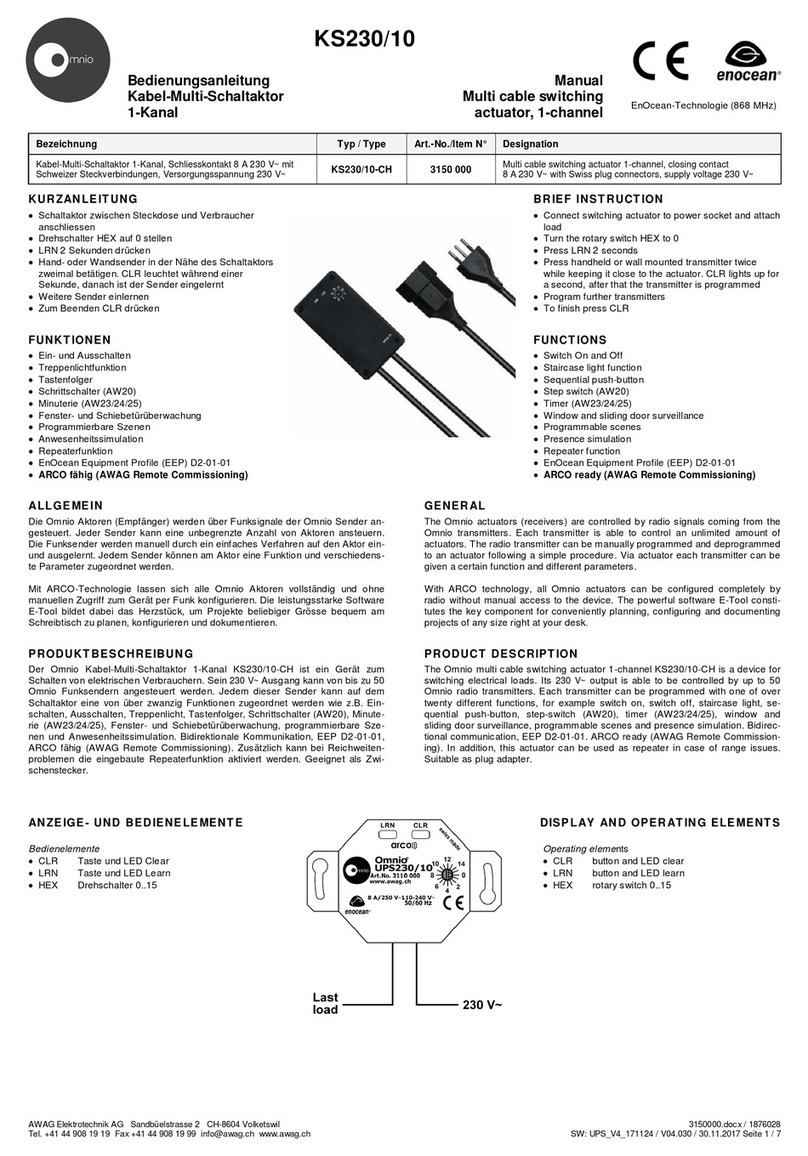Sullair WSPC User manual

Failure to follow the instructions
and procedures in this manual or,
misuse of this equipment will
VOID its warranty!
WARRANTY NOTICE
PART NUMBER:
KEEP FOR
FUTURE
REFERENCE
USER MANUAL
©SULLAIR CORPORATION
The information in this manual is current
as of its publication date, and applies to
compressor serial number:
and all subsequent serial numbers.
02250167-859 R01
200710010000
WSPC USER INTERFACE MANUAL
FOR THE WS CONTROLLER™

AIR CARE SEMINAR TRAINING
Sullair Air Care Seminars are courses that provide hands-on instruction for the proper operation, maintenance,
and servicing of Sullair products. Individual seminars on Industrial compressors and compressor electrical
systems are offered at regular intervals throughout the year at Sullair’s corporate headquarters training facility
located at Michigan City, Indiana.
Instruction includes training on the function and installation of Sullair service parts, troubleshooting common
faults and malfunctions, and actual equipment operation. These seminars are recommended for maintenance,
contractor maintenance, and service personnel.
For detailed course outlines, schedule, and cost information contact:
SULLAIR CUSTOMER CARE TRAINING DEPARTMENT
1-888-SULLAIR or
219-879-5451 (ext. 5623)
www.sullair.com
- Or Write -
Sullair Corporation
3700 E. Michigan Blvd.
Michigan City, IN 46360
Attn: Service Training Department.

TABLE OF CONTENTS
SECTION 1—SAFETY
5 1.1 GENERAL
5 1.2 PERSONAL PROTECTIVE EQUIPMENT
5 1.3 PRESSURE RELEASE
6 1.4 FIRE AND EXPLOSION
6 1.5 MOVING PARTS
7 1.6 HOT SURFACES, SHARP EDGES AND SHARP CORNERS
7 1.7 TOXIC AND IRRITATING SUBSTANCES
8 1.8 ELECTRICAL SHOCK
8 1.9 LIFTING
9 1.10 ENTRAPMENT
SECTION 2—OVERVIEW
11 2.1 MANUAL CONTENTS
12 2.2 SYSTEM COMPATIBILITY
12 2.3 INSTALLING THE WSPC USER INTERFACE SOFTWARE
12 2.4 INSTALLING OR UPDATING THE FRAMEWORK
12 2.5 UNINSTALL THE WSPC SOFTWARE
SECTION 3—GETTING STARTED
13 3.1 ACCESS PRIVILEGES
13 3.2 STARTING THE SOFTWARE
14 3.3 WINDOWS® BASIC
15 3.4 CONNECTING THE PC TO THE CONTROLLER
15 3.5 CONNECTING / DISCONNECTING THE WSPC USER INTERFACE AND
THE WS CONTROLLER
17 3.6 THE WSPC DISPLAY SCREEN
17 3.7 COMPRESSOR STATUS BAR
18 3.8 FILE MENU
19 3.9 REPORT
19 3.10 COM PORT
19 3.11 ABOUT

TABLE OF CONTENTS
SECTION 4—DISPLAY DESCRIPTIONS
21 4.1 COMPRESSOR STATUS BAR
22 4.2 COMPRESSOR DATA DISPLAY (DEFAULT SCREEN)
24 4.3 MACHINE INFO DISPLAY
24 4.4 SERVICE DISPLAY
27 4.5 MAINTENANCE DISPLAY
28 4.6 DISTRIBUTOR INFORMATION
29 4.7 SEQUENCE SYSTEM DISPLAY
30 4.8 ADJUSTMENTS DISPLAY
SECTION 5—MENU BAR
39 5.1 FILE MENU—USER PROFILES AND PREFERENCES
43 5.2 REPORTS
44 5.3 COMMUNICATIONS PORT
45 5.4 INFORMATION ABOUT WSPC
SECTION 6—VARIABLE SPEED DRIVE (VSD)
47 6.1 VSD OPERATION
47 6.2 COMPRESSOR DATA TAB
48 6.3 VSD PERFORMANCE DATA
49 6.4 CLEAR RECENT DATA
49 6.5 DELIVERY HISTORY
50 6.6 SERVICE DISPLAY TAB
50 6.7 MAIN MOTOR VFD STATUS BOX
51 6.8 ADJUSTMENTS TAB
52 6.9 ADMINISTRATOR LEVEL VSD ADJUSTMENTS
SECTION 7—ADMININISTRATOR LEVEL FUNCTIONS
53 7.1 ADMINISTRATOR LEVEL FUNCTIONS
53 7.2 ACCESSING THE ADMINISTRATOR LEVEL
54 7.3 COMMISSIONING A CONTROLLER
56 7.4 MAINTENANCE DISPLAY
59 7.5 ADMINISTRATOR ADJUSTMENTS (ADMIN) DISPLAY
67 7.6 MODBUS FUNCTIONS
69 7.7 DRYER SETUP DISPLAY

Section 1
5
SAFETY
1.1 GENERAL
Sullair Corporation and its subsidiaries design and
manufacture all of their products so they can be
operated safely. However, the responsibility for safe
operation rests with those who use and maintain
these products. The following safety precautions are
offered as a guide which, if conscientiously followed,
will minimize the possibility of accidents throughout
the useful life of this equipment.
The compressor should be operated only by those
who have been trained and delegated to do so, and
who have read and understood this Operator's
Manual. Failure to follow the instructions, procedures
and safety precautions in this manual may result in
accidents and injuries. NEVER start the compressor
unless it is safe to do so. DO NOT attempt to operate
the compressor with a known unsafe condition. Tag
the compressor and render it inoperative by
disconnecting and locking out all power at source or
otherwise disabling its prime mover so others who
may not know of the unsafe condition cannot attempt
to operate it until the condition is corrected.
Install, use and operate the compressor only in full
compliance with all pertinent OSHA regulations and/
or any applicable Federal, State, and Local codes,
standards and regulations. DO NOT modify the
compressor and/or controls in any way except with
written factory approval.
While not specifically applicable to all types of
compressors with all types of prime movers, most of
the precautionary statements contained herein are
applicable to most compressors and the concepts
behind these statements are generally applicable to
all compressors.
1.2 PERSONAL PROTECTIVE
EQUIPMENT
A. Prior to installing or operating the compressor,
owners, employers and users should become
familiar with, and comply with, all applicable
OSHA regulations and/or any applicable Federal,
State and Local codes, standards, and regula-
tions relative to personal protective equipment,
such as eye and face protective equipment,
respiratory protective equipment, equipment
intended to protect the extremities, protective
clothing, protective shields and barriers and elec-
trical protective equipment, as well as noise
exposure administrative and/or engineering con-
trols and/or personal hearing protective equip-
ment.
1.3 PRESSURE RELEASE
A. Install an appropriate flow-limiting valve between
the service air outlet and the shut-off (throttle)
valve, either at the compressor or at any other
point along the air line, when an air hose exceed-
ing 1/2" (13mm) inside diameter is to be con-
nected to the shut-off (throttle) valve, to reduce
pressure in case of hose failure, per OSHA Stan-
dard 29 CFR 1926.302(b)(7) and/or any applica-
ble Federal, State and Local codes, standards
and regulations.
B. When the hose is to be used to supply a mani-
fold, install an additional appropriate flow-limiting
valve between the manifold and each air hose
exceeding 1/2" (13mm) inside diameter that is to
be connected to the manifold to reduce pressure
in case of hose failure.
C. Provide an appropriate flow-limiting valve at the
beginning of each additional 75 feet (23m) of
hose in runs of air hose exceeding 1/2" (13mm)
NOTE
OPERATOR IS REQUIRED TO READ
ENTIRE INSTRUCTION MANUAL.

SECTION 1
6
inside diameter to reduce pressure in case of
hose failure.
D. Flow-limiting valves are listed by pipe size and
flow-rated. Select appropriate valves accordingly,
in accordance with their manufacturer's recom-
mendations.
E. DO NOT use air tools that are rated below the
maximum rating of the compressor. Select air
tools, air hoses, pipes, valves, filters and other
fittings accordingly. DO NOT exceed manufac-
turer's rated safe operating pressures for these
items.
F. Secure all hose connections by wire, chain or
other suitable retaining device to prevent tools or
hose ends from being accidentally disconnected
and expelled.
G. Open fluid filler cap only when compressor is not
running and is not pressurized. Shut down the
compressor and bleed the receiver tank to zero
internal pressure before removing the cap.
H. Vent all internal pressure prior to opening any
line, fitting, hose, valve, drain plug, connection or
other component, such as filters and line oilers,
and before attempting to refill optional air line
anti-icer systems with antifreeze compound.
I. Keep personnel out of line with and away from
the discharge opening of hoses or tools or other
points of compressed air discharge.
J. DO NOT use air at pressures higher than 2.1 bar
for cleaning purposes, and then only with effec-
tive chip guarding and personal protective equip-
ment per OSHA Standard 29 CFR 1910.242 (b)
and/or any applicable Federal, State, and Local
codes, standards and regulations.
K. DO NOT engage in horseplay with air hoses as
death or serious injury may result.
1.4 FIRE AND EXPLOSION
A. Clean up spills of lubricant or other combustible
substances immediately, if such spills occur.
B. Shut off the compressor and allow it to cool.
Then keep sparks, flames and other sources of
ignition away and DO NOT permit smoking in the
vicinity when checking or adding lubricant or
when refilling air line anti-icer systems with anti-
freeze compound.
C. DO NOT permit fluids, including air line anti-icer
system antifreeze compound or fluid film, to
accumulate on, under or around acoustical mate-
rial, or on any external surfaces of the air com-
pressor. Wipe down using an aqueous industrial
cleaner or steam clean as required. If necessary,
remove acoustical material, clean all surfaces
and then replace acoustical material. Any acous-
tical material with a protective covering that has
been torn or punctured should be replaced
immediately to prevent accumulation of liquids or
fluid film within the material. DO NOT use flam-
mable solvents for cleaning purposes.
D. Disconnect and lock out all power at source prior
to attempting any repairs or cleaning of the com-
pressor or of the inside of the enclosure, if any.
E. Keep electrical wiring, including all terminals and
pressure connectors in good condition. Replace
any wiring that has cracked, cut, abraded or oth-
erwise degraded insulation, or terminals that are
worn, discolored or corroded. Keep all terminals
and pressure connectors clean and tight.
F. Keep grounded and/or conductive objects such
as tools away from exposed live electrical parts
such as terminals to avoid arcing which might
serve as a source of ignition.
G. Remove any acoustical material or other material
that may be damaged by heat or that may sup-
port combustion and is in close proximity, prior to
attempting weld repairs.
H. Keep suitable fully charged Class BC or ABC fire
extinguisher or extinguishers nearby when ser-
vicing and operating the compressor.
I. Keep oily rags, trash, leaves, litter or other com-
bustibles out of and away from the compressor.
J. DO NOT operate the compressor without proper
flow of cooling air or water or with inadequate
flow of lubricant or with degraded lubricant.
K. DO NOT attempt to operate the compressor in
any classification of hazardous environment
unless the compressor has been specially
designed and manufactured for that duty.
1.5 MOVING PARTS
A. Keep hands, arms and other parts of the body
and also clothing away from couplings, fans and
other moving parts.
B. DO NOT attempt to operate the compressor with
the fan, coupling or other guards removed.

SECTION 1
7
C. Wear snug-fitting clothing and confine long hair
when working around this compressor, especially
when exposed to hot or moving parts.
D. Keep access doors, if any, closed except when
making repairs or adjustments.
E. Make sure all personnel are out of and/or clear of
the compressor prior to attempting to start or
operate it.
F. Disconnect and lock out all power at source and
verify at the compressor that all circuits are de-
energized to minimize the possibility of acciden-
tal start-up, or operation, prior to attempting
repairs or adjustments. This is especially impor-
tant when compressors are remotely controlled.
G. Keep hands, feet, floors, controls and walking
surfaces clean and free of fluid, water or other
liquids to minimize the possibility of slips and
falls.
1.6 HOT SURFACES, SHARP
EDGES AND SHARP
CORNERS
A. Avoid bodily contact with hot fluid, hot coolant,
hot surfaces and sharp edges and corners.
B. Keep all parts of the body away from all points of
air discharge.
C. Wear personal protective equipment including
gloves and head covering when working in, on or
around the compressor.
D. Keep a first aid kit handy. Seek medical assis-
tance promptly in case of injury. DO NOT ignore
small cuts and burns as they may lead to infec-
tion
1.7 TOXIC AND IRRITATING
SUBSTANCES
A. DO NOT use air from this compressor for respi-
ration (breathing) except in full compliance with
OSHA Standards 29 CFR 1910 and/or any appli-
cable Federal, State or Local codes or regula-
tions.
B. DO NOT use air line anti-icer systems in air lines
supplying respirators or other breathing air utili-
zation equipment and DO NOT discharge air
from these systems into unventilated or other
confined areas.
C. Operate the compressor only in open or ade-
quately ventilated areas.
D. Locate the compressor or provide a remote inlet
so that it is not likely to ingest exhaust fumes or
other toxic, noxious or corrosive fumes or sub-
stances.
E. Coolants and lubricants used in this compressor
are typical of the industry. Care should be taken
to avoid accidental ingestion and/or skin contact.
In the event of ingestion, seek medical treatment
promptly. Wash with soap and water in the event
of skin contact. Consult Material Safety Data
Sheet for information pertaining to fluid of fill.
F. Wear goggles or a full face shield when adding
antifreeze compound to air line anti-icer systems.
G. If air line anti-icer system antifreeze compound
enters the eyes or if fumes irritate the eyes, they
should be washed with large quantities of clean
water for fifteen minutes. A physician, preferably
an eye specialist, should be contacted immedi-
ately.
H. DO NOT store air line anti-icer system antifreeze
compound in confined areas.
I. The antifreeze compound used in air line anti-
freeze systems contains methanol and is toxic,
harmful or fatal if swallowed. Avoid contact with
the skin or eyes and avoid breathing the fumes. If
DANGER
Death or serious injury can result from
inhaling compressed air without using
proper safety equipment. See OSHA stan-
dards and/or any applicable Federal, State,
and Local codes, standards and regulations
on safety equipment.

SECTION 1
8
swallowed, induce vomiting by administering a
tablespoon of salt, in each glass of clean, warm
water until vomit is clear, then administer two
teaspoons of baking soda in a glass of clean
water. Have patient lay down and cover eyes to
exclude light. Call a physician immediately.
1.8 ELECTRICAL SHOCK
A. This compressor should be installed and main-
tained in full compliance with all applicable Fed-
eral, State and Local codes, standards and
regulations, including those of the National Elec-
trical Code, and also including those relative to
equipment grounding conductors, and only by
personnel that are trained, qualified and dele-
gated to do so.
B. Keep all parts of the body and any hand-held
tools or other conductive objects away from
exposed live parts of electrical system. Maintain
dry footing, stand on insulating surfaces and DO
NOT contact any other portion of the compressor
when making adjustments or repairs to exposed
live parts of the electrical system. Make all such
adjustments or repairs with one hand only, so as
to minimize the possibility of creating a current
path through the heart.
C. Attempt repairs in clean, dry and well lighted and
ventilated areas only.
D. DO NOT leave the compressor unattended with
open electrical enclosures. If necessary to do so,
then disconnect, lock out and tag all power at
source so others will not inadvertently restore
power.
E. Disconnect, lock out, and tag all power at source
prior to attempting repairs or adjustments to
rotating machinery and prior to handling any
ungrounded conductors.
1.9 LIFTING
A. If the compressor is provided with a lifting bail,
then lift by the bail provided. If no bail is provided,
then lift by sling. Compressors to be air-lifted by
helicopter must not be supported by the lifting
bail but by slings instead. In any event, lift and/or
handle only in full compliance with OSHA stan-
dards 29 CFR 1910 subpart N and/or any appli-
cable Federal, State, and Local codes, standards
and regulations.
B. Inspect points of attachment for cracked welds
and for cracked, bent, corroded or otherwise
degraded members and for loose bolts or nuts
prior to lifting.
C. Make sure entire lifting, rigging and supporting
structure has been inspected, is in good condi-
tion and has a rated capacity of at least the
weight of the compressor. If you are unsure of
the weight, then weigh compressor before lifting.
D. Make sure lifting hook has a functional safety
latch or equivalent, and is fully engaged and
latched on the bail or slings.
E. Use guide ropes or equivalent to prevent twisting
or swinging of the compressor once it has been
lifted clear of the ground.
F. DO NOT attempt to lift in high winds.
G. Keep all personnel out from under and away
from the compressor whenever it is suspended.
H. Lift compressor no higher than necessary.
DANGER
All field equipment must be tested for elec-
trostatic fields prior to servicing or making
contact with the machine using the follow-
ing or equivalent test equipment:
• 90-600 VAC: Volt detector such as
Fluke Model 1AC-A
• 600-7000 VAC: Voltage detector
such as Fluke Networks Model
C9970
It is the responsibility of each organization
to provide/arrange training for all their
associates expected to test for electrostatic
fields.

SECTION 1
9
I. Keep lift operator in constant attendance when-
ever compressor is suspended.
J. Set compressor down only on a level surface
capable of safely supporting at least its weight
and its loading unit.
K. When moving the compressor by forklift truck,
utilize fork pockets if provided. Otherwise, utilize
pallet if provided. If neither fork pockets or pallet
are provided, then make sure compressor is
secure and well balanced on forks before
attempting to raise or transport it any significant
distance.
L. Make sure forklift truck forks are fully engaged
and tipped back prior to lifting or transporting the
compressor.
M. Forklift no higher than necessary to clear obsta-
cles at floor level and transport and corner at
minimum practical speeds.
N. Make sure pallet-mounted compressors are
firmly bolted or otherwise secured to the pallet
prior to attempting to forklift or transport them.
NEVER attempt to forklift a compressor that is
not secured to its pallet, as uneven floors or sud-
den stops may cause the compressor to tumble
off, possibly causing serious injury or property
damage in the process.
1.10 ENTRAPMENT
A. If the compressor enclosure, if any, is large
enough to hold a man and if it is necessary to
enter it to perform service adjustments, inform
other personnel before doing so, or else secure
and tag the access door in the open position to
avoid the possibility of others closing and possi-
bly latching the door with personnel inside.
B. Make sure all personnel are out of compressor
before closing and latching enclosure doors.

10
BLANK PAGE

Section 2
11
WSPC USER INTERFACE MANUAL
OVERVIEW
The WSPC User Interface is a Windows-based
software program that allows complete monitoring
and control of Sullair air compressors equipped with
a Sullair WS Controller. The software can monitor a
single compressor operating as an individual unit or
multiple machines connected in a sequence. The
WSPC program receives data about the compressor
from the WS Controller, assigns control parameters
to the controller, displays controller operating
characteristics including faults and warning
messages, and provides functionality that assists the
user with controller diagnostics.
2.1 MANUAL CONTENTS
This manual describes the features and operation of
the WSPC User Interface program. Part 1 covers
material pertaining specifically to persons operating
the program with User Level access. Part 2 covers
advanced functions available to experienced users
and persons with Administrator Level access.
This manual describes WSPC software part number
02250174-081 when operated with WS Controller
software 02250174-082 or later. This version of
WSPC is compatible with all previously released
versions of WS Controller software, but certain
features described in this manual are not available in
earlier versions.
Part 1:
Section 2: OVERVIEW provides the necessary
information to install the WSPC software. Included
are the minimum hardware and software
requirements.
Section 3: GETTING STARTED presents steps to
getting the program up and running quickly. Basic
MS Windows functions and those features necessary
to using the software are explained in this section.
Section 4: DISPLAY DESCRIPTIONS provides an
explanation of each display screen available to user
level operators. Detailed descriptions of the
operation of each display component are provided.
Section 5: MENU BAR provides steps to setting user
preferences for operating the WSPC program. This
section guides the user in creating and modifying
user profiles.
Section 6: VARIABLE SPEED DRIVE (VSD)
describes the WSPC functions that apply to Variable
Speed Drive compressors.
Part 2:
Section 7: ADMININISTRATOR LEVEL FUNCTIONS
describes those functions that apply specifically to
Administrator level operators. Each administrator
level display is presented and details of the display
components are described.
Features of the WSPC User Interface software
include:
• Two-way communication channel between the user
and the compressor controller.
• A comprehensive view of the compressor control-
ler’s operation at the WSPC interface.
• Adjustment of all modifiable parameters of the com-
pressor controller.
• Ability to control the compressor remotely.
• Access to data relating to all compressors con-
nected as a sequence system.
• Password protection capabilities to limit access to
data and controls.
• A data log feature which compiles operational, ser-
vice, and error data of the compressor or compres-
sor system.

WSPC USER INTERFACE MANUAL SECTION 2
12
2.2 SYSTEM COMPATIBILITY
• Before beginning the installation process, your
computer should meet the following minimum
requirements.
• PC–compatible computer (Pentium® IV based, 1.0
Ghz processor recommended)
• Windows 2000 or Windows XP operating systems.
Windows 2000 may require special processing soft-
ware to properly operate the WSPC software.
• CD ROM drive
• 125 Mb of available hard disk space
• 256 Mb of available RAM memory
• Color monitor
• RS232 communications capability
2.3 INSTALLING THE WSPC
USER INTERFACE
SOFTWARE
Follow the instructions accompanying the WSPC
Installation package. The actual installation media
may be CD, internet, network, USB drive, or other
means, and the procedure will be specific to that
media. This installation will create a folder on your
disk drive, and install the necessary files into that
folder. Make a note of this location, as it may be
necessary for future updates. The default location for
all saved files will also be in that folder, but you may
browse to save into any other location in your PC as
desired. By default, the folder will be "WSPC" and will
be located in a "Sullair" folder. Recommended
locations are "C:\Sullair\WSPC" or
"D:\Sullair\WSPC”.
2.4 INSTALLING OR UPDATING
THE FRAMEWORK
The WSPC software requires the Microsoft .net®
Framework support program in order to run on the
PC. If Microsoft .net is already on the PC, you will be
able to run as soon as the installation is completed.
To install the framework, or update to the latest
version, use the following procedure for a free
download.
1. Connect the PC to the internet.
2. Go to the site: www.microsoft.com/down-
loads
3. Search for “.NET Framework”
4. Follow the instructions for downloading and
installation.
2.5 UNINSTALL THE WSPC
SOFTWARE
To uninstall the WSPC software:
1. Right-click any desktop shortcuts that were
created.
2. Click “Delete” to delete the shortcut.
3. Open “My Computer” and browse to the
folder created in Section 2.3.
4. Delete the folder and its contents.
NOTE
Contact your network administrator if you
are unable to perform the software
installation due to access limitations.

Section 3
13
WSPC USER INTERFACE MANUAL
GETTING STARTED
3.1 ACCESS PRIVILEGES
The WSPC User Interface program may be
accessed at two levels.
User Level: Allows users to access the program
without entering a password. The user should be an
individual with specific authorization to use the
WSPC software and knowledge of the compressor
operation. This level includes all data and
adjustments for normal applications of the
compressor. At this level a user has access to the
following displays: Compressor Data, Machine Info,
Service, Maintenance, Sequencing, and
Adjustments.
Administrator Level: This provides additional
functions for maintenance, service, and setup for
trained compressor technicians. Administrator level
functions are described in Part 2 of this manual. A
password is required to access this level.
3.2 STARTING THE SOFTWARE
1. Click the shortcut located on the computer
desktop to start the WSPC User Interface
program.
2. When the program opens, a dialog box will
appear as shown in Figure 3-1. Click OK to
open the WSPC program. If the program
was last closed while operating at the
Administrator level the dialog box will require
a password as shown in Figure 3-2.
Do the following to select a user-level profile:
A. Click the down arrow next to the “User Name”
box. A drop-down list of user profiles will be pre-
sented. See Figure 3-3.
B. Click on a profile that is set for “User Level”
access (Default User) and click “OK”. User level
profiles do not require password access. More
profile options may be available in the User
Name list than the ones shown in Figure 3-3.
Figure 3-1: WSPC User Interface password
request
Figure 3-2: WSPC User Interface password
request

WSPC USER INTERFACE MANUAL SECTION 3
14
The program will open to the “Compressor Data
Display” with user level access. See Figure 3-4.
From the opening screen the user may navigate to all
other features of the program.
3.3 WINDOWS® BASIC
This section presents basic MS Windows® functions
that will be useful to using the WSPC program. The
active presentations of information on the computer
screen are referred to as “Displays.” At the top of
each display is a tab showing the display title. To
make a display active, click on the desired display
tab. See Figure 3-5. The active display allows the
user to see the data related to the tab title and to
perform functions on the display page.
Figure 3-3: User Option
Figure 3-4: WSPC Opening Window – Compressor Data Display

SECTION 3 WSPC USER INTERFACE MANUAL
15
Some screens allow for entry of values into fields on
the screen. To enter data into a field:
A. Click in the field to be modified.
B. Select the data currently contained in the field (if
any). Data in a field can be selected by double-
clicking on a character in a field. The entire data
field will be selected. Data can also be high-
lighted for editing by holding down the left mouse
button and dragging the cursor across the data in
the field.
C. Type the new data into the field. Typing the new
data will replace the old data.
Typically an option can be chosen by pressing
“Enter” on the computer keyboard. Some options
present a dialog box that allow the user to confirm
the entries by clicking an “OK” button or cancel the
entries by clicking “Cancel.” A window can be
reduced, expanded, or closed by clicking on the
respective button located in the upper right corner of
the display:
3.4 CONNECTING THE PC TO
THE CONTROLLER
The standard connection of the PC Interface to the
WS Controller is via a specially designed RS-232
connector. This serial line connects to the computer’s
DB9 socket and runs directly to a custom designed
terminal located on the left side of the controller
cabinet. The PC may also be connected to the
controller by other means such as through RS-485
connections or remotely via modem or wireless
network.
3.5 CONNECTING /
DISCONNECTING THE WSPC
USER INTERFACE AND THE
WS CONTROLLER
After the communication lines are attached and the
WSPC software is running, the WSPC program can
be connected to the controller to begin receiving
machine operation data. Control data can also be
sent from the PC to the WS Controller to configure
the machine control parameters.
1. To establish connection between the WSPC
and the WS Controller click
(“Connect” button)
in the status bar. The box left of the Connect
button will appear bright green indicating the
connection is active. The software will
search for communication from the control-
ler, and fill the display with machine informa-
tion.
2. During normal connection, communication
activity will be shown on the bottom edge of
the WSPC screen, as shown in Figure 3-7.
The progress bar and block numbers simply
indicate that communications are occurring.
The WS Controller also provides led indica-
tors for communication near J13. Red indi-
cates a request was received from the PC,
Green indicates a message is being sent to
the PC.
Figure 3-5: User Interface display tab
Reduce Expand Close
Figure 3-6: User Option

WSPC USER INTERFACE MANUAL SECTION 3
16
3. If communication with the machine could not
be established, an error message will display
on the communication status line as depicted
in Figure 3-8. If this occurs, check the RS-
232 connection and other terminals for
proper connection.
4. To disconnect communication between the
WSPC and the controller, click on the “Con-
nect” button. The box left of the button will
change from bright green to dark, shaded
green, indicating that the WSPC is discon-
nected from the controller. The controller will
continue to operate according to the latest
set of parameters entered.
Figure 3-7: WSPC User Interface Display Screen
Figure 3-8: WSPC User Interface Display Screen
User Profile
Name
Communication
Status Indicator
Logging
Indicator
Menu Bar
Compressor
Status Bar
Connection
Button
Machine
Operation
Data and
Parameters
Title Bar
Figure 3-9: WSPC User Interface Display Screen
Display Tabs

SECTION 3 WSPC USER INTERFACE MANUAL
17
3.6 THE WSPC DISPLAY
SCREEN
The WSPC display screen consists of the title bar,
the pull-down menu bar, the compressor status bar,
display tabs, machine operation data display, and the
communication status bar. Refer to Figure 3-9. The
default screen is the Compressor Data display which
appears each time the WSPC software is opened.
Listed below are main elements of the screen display
that enable the user to access and view the machine
operation data, and modify the machine control
parameters.
Title Bar—Contains the name of the WSPC software
program.
"Menu Bar - Click to activate drop-down menus or
other screens to select WSPC configurations.
Section 5 provides additional details.
Connection Button—When activated, establishes
connection between the PC Interface and the WS
Controller unit.
Compressor Status Bar—Located on the left
margin of every display, the Compressor Status Bar
provides real-time data of the machine’s current
operation and condition. The Compressor Status Bar
is described in detail in Section 3.7.
Display Tabs—Allow for the selection of the desired
display. Section 4 provides a detailed description of
each display screen.
Machine Operation Data—Area where the machine
parameter data and operational information is
displayed.
Communication Status Indicator—Located at the
bottom of the display window, this line provides
communication status information.
User Profile Name—The name of the current user
profile is displayed. In Figure 3-9, the active profile is
named “Default User”.
Logging Indicator—This field will light when the PC
is recording data.
3.7 COMPRESSOR STATUS BAR
The Compressor Status Bar, which is located left of
the main window, displays real-time data regarding
the status of the compressor. The status bar is
constantly displayed whenever the WSPC software
is connected to the controller. This feature allows the
user to quickly view the status of the compressor
operation regardless of which display screen is
active. Information presented in the status bar
includes the compressor operating mode, operating
state, compressor temperature, sump pressure, and
discharge pressure. See Figure 3-9.
The Compressor Status Bar can be displayed as a
stand alone compressor operation monitor as shown
in Figure 3-10. The full display window can be hidden
leaving only the status bar information appearing on
the screen. This feature allows the user to continue
monitoring the compressor operation while
performing other tasks on the PC.
To reduce the display to show only the status bar:
1. Place the cursor on the right border of the
WSPC display window.
2. Press and hold the left mouse button.
3. “Drag” the display border to the left until it
stops. The compressor data window will be
hidden leaving the status bar in the display.
4. To return to the full screen presentation, click
on the expand window icon in the upper
right corner of the display.
5. To return again to the status bar only view,
click on the reduce window icon in the upper
right corner of the display.

WSPC USER INTERFACE MANUAL SECTION 3
18
3.8 FILE MENU
The File Menu contains options that allow the user to
configure and set preferences that control how the
program functions. See Figure 3-10 From the “File”
menu, the user can choose three options:
Profiles—Allows the user to create and edit profiles.
A profile will contain settings that configure the
WSPC program according to the operator or group’s
preferences. The features of the Profiles menu
option are described in Section 5 of this manual.
Login—Presents the Login box which allows the
user to choose a profile from a list of available User
profiles. See Figure 3-12.
Exit—Closes the WSPC User Interface program.
Exiting the software does not affect the compressor
or controller operation.
Communication
Operating Mode
Communication
Operating State
Communication
Temperature
Measurement
Sump Pressure
Measurement
Communication
Pressure
Discharge
Figure 3-10: Compressor Status Bar (Reduced)
File Menu
Figure 3-11: File Menu Options

SECTION 3 WSPC USER INTERFACE MANUAL
19
3.9 REPORT
This menu Item will request a folder location and file
name in which to file a comprehensive service report.
See Figure 3-13
3.10 COM PORT
This provides a dialog to select the communications
port of the PC on which the program is running. This
is typically COM1, but your PC may be equipped with
additional ports. See Figure 3-15
3.11 ABOUT
This provides information about the WSPC program.
See Figure 3-14
Figure 3-12: Login Screen A
Figure 3-13: Report Dialog
Figure 3-14: About Information Box

WSPC USER INTERFACE MANUAL SECTION 3
20
Figure 3-15: Com Port Dialog
Other manuals for WSPC
1
Table of contents
Other Sullair Controllers manuals

Sullair
Sullair ShopTek User manual
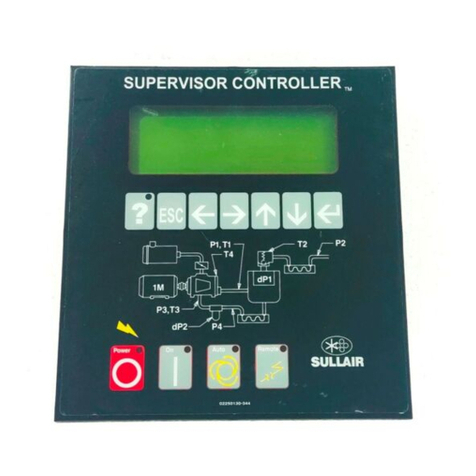
Sullair
Sullair SUPERVISOR CONTROLLER Series User manual
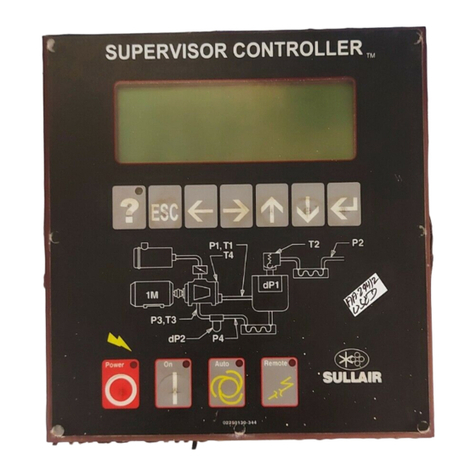
Sullair
Sullair SUPERVISOR CONTROLLER User manual
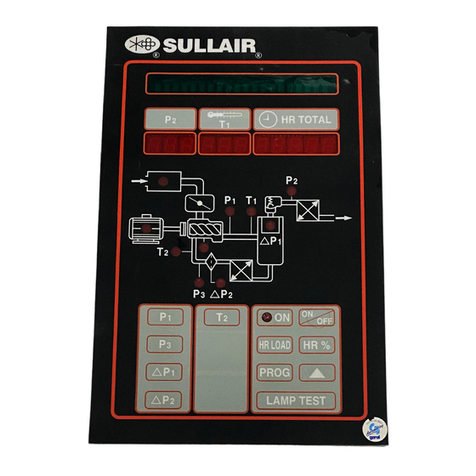
Sullair
Sullair SUPERVISOR CONTROLLER User manual
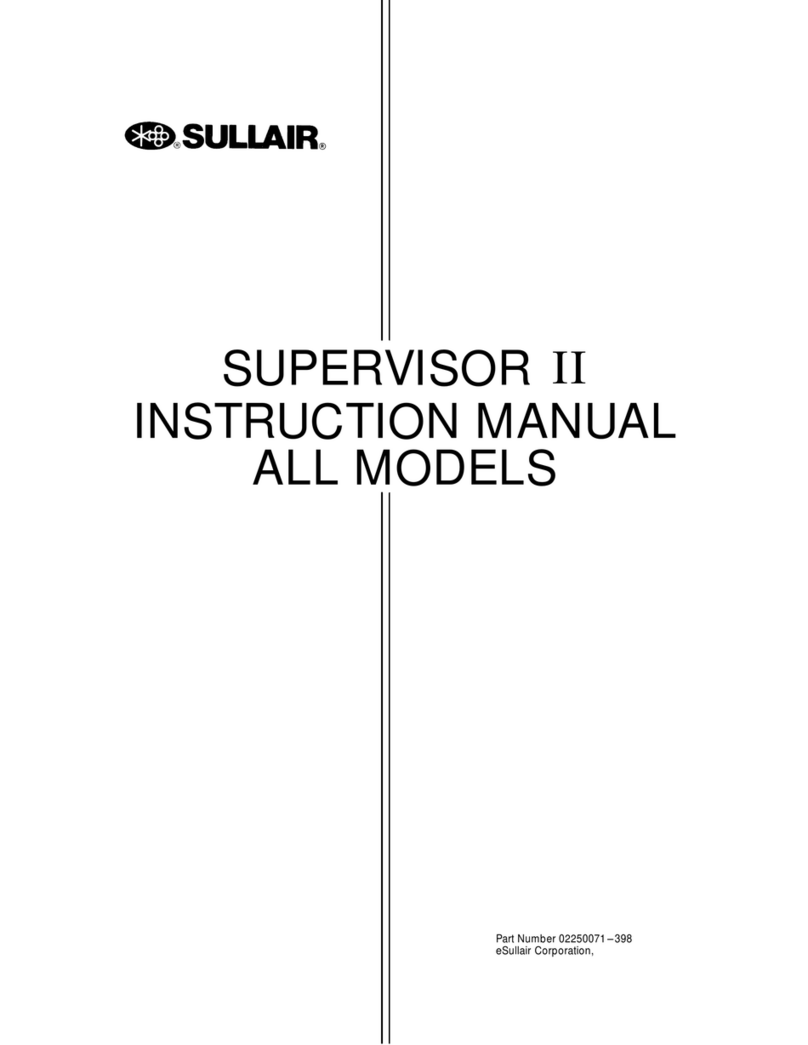
Sullair
Sullair Supervisor II User manual
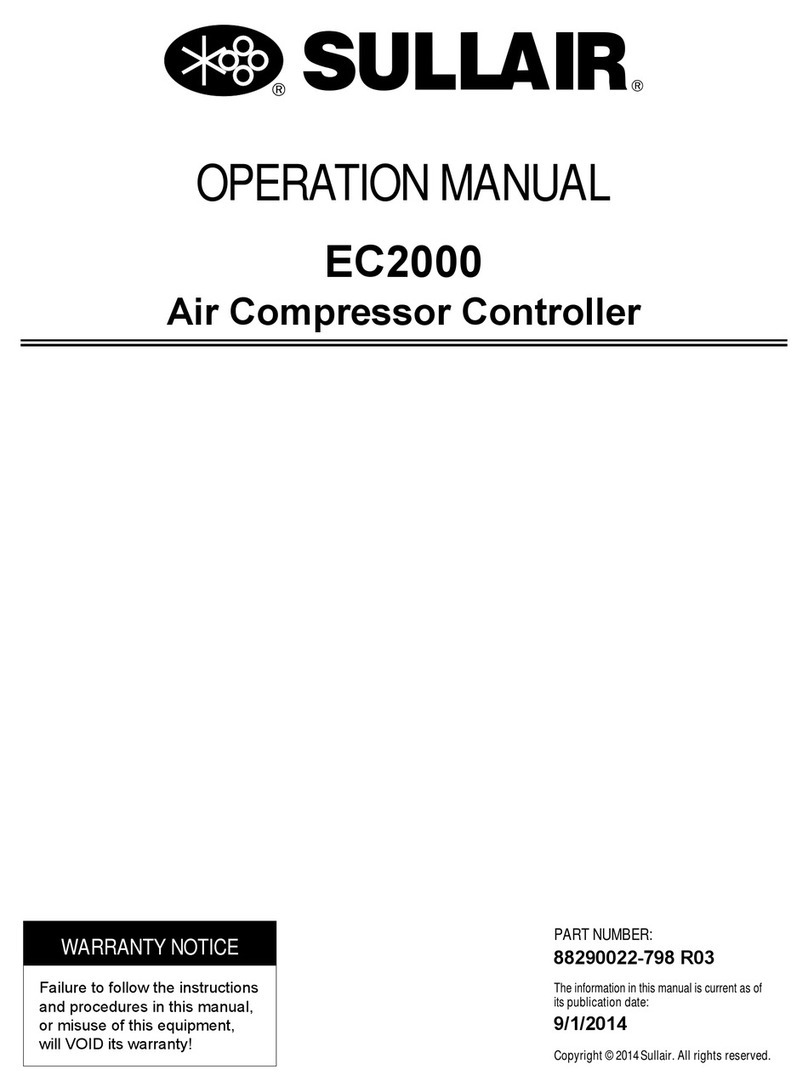
Sullair
Sullair EC2000 User manual

Sullair
Sullair 02250160-842 User manual
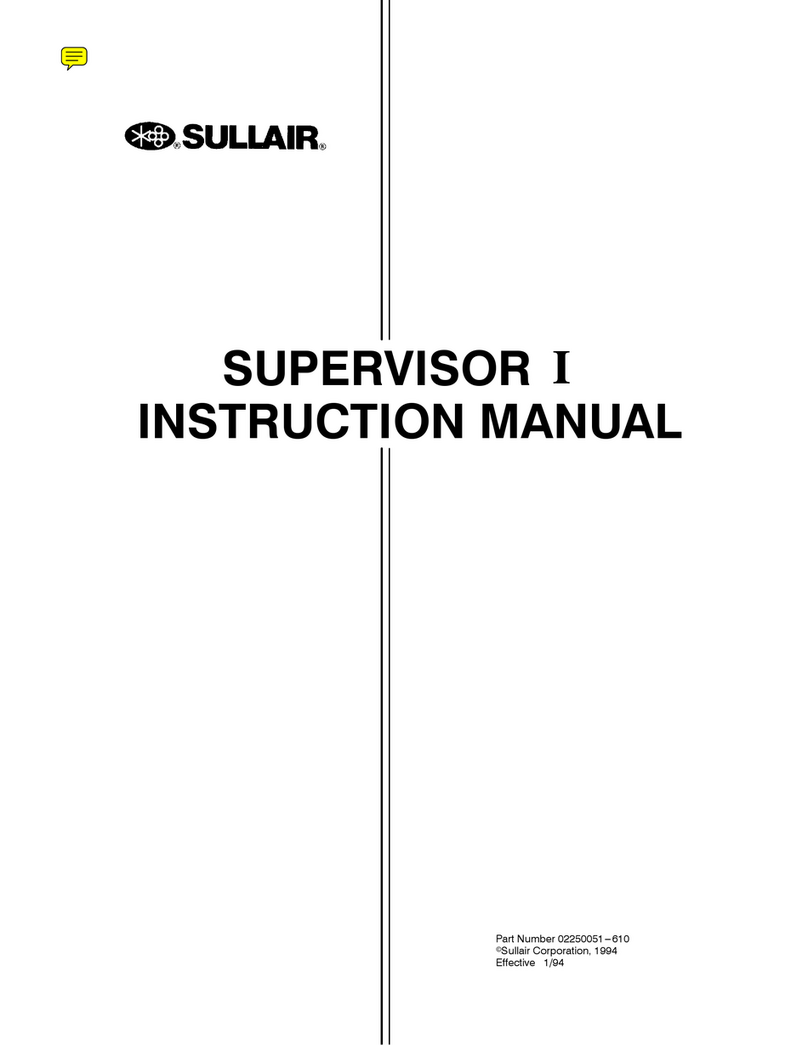
Sullair
Sullair SUPERVISOR I User manual
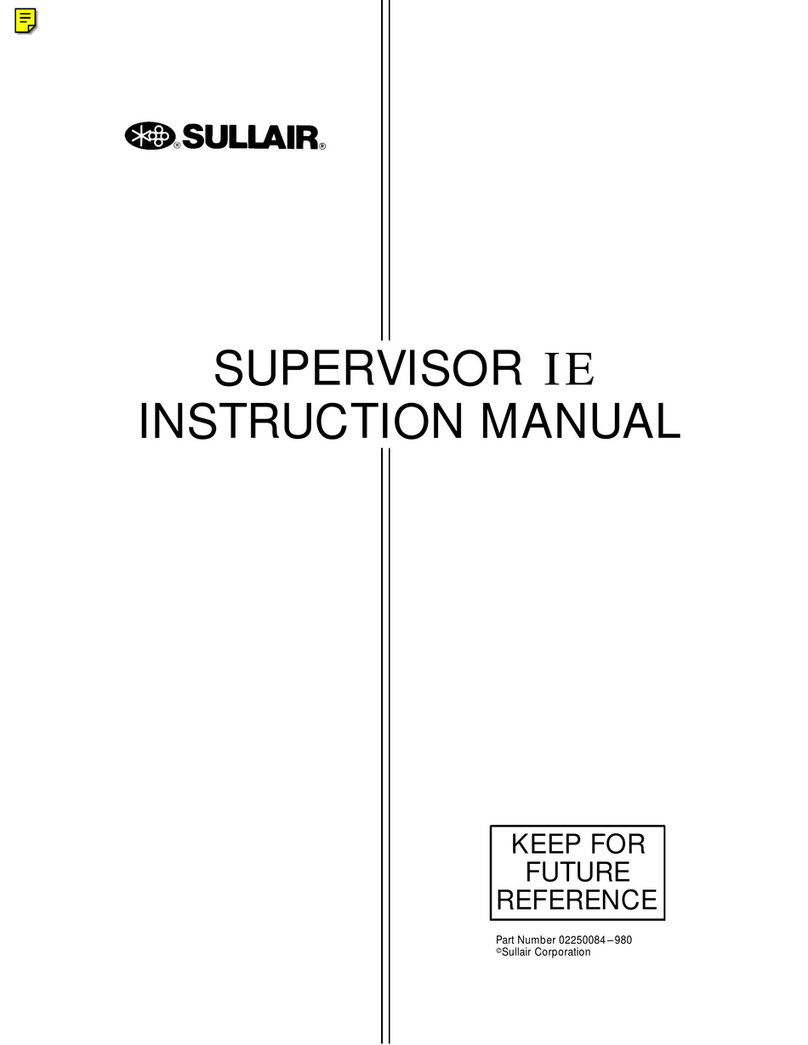
Sullair
Sullair Supervisor IE User manual

Sullair
Sullair SUPERVISOR CONTROLLER User manual



